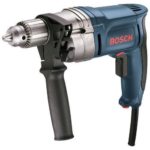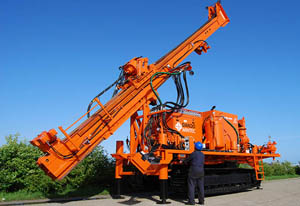Earth Boring Technology
Boring: penetration methods, bore stabilization methods and removal of debris from hole
Boring or Earth drilling is a process of making a cylindrical hole into the earth that is long in comparison to its diameter, for the purpose of exploration, foundation, blasting, mining, groundwater collection etc. Boring should achieve three purposes: penetration of substrate, stabilization of drilled bore-hole and removal of debris from drill-hole.
The Three Aspects of Boring
Penetration of earth is achieved during boring by impact or abrasion of a drilling tool. Following methods or combination thereof, are employed for penetration:
- Percussion drilling, where fragmentation of substrate is achieved by the impact of a hammer either at top or bottom of drill-hole. Transmission is usually mechanical. Percussion drilling tools include Wash boring chisel, drop chisel, bailer, grabbing tools (clamshell, hammer grab) etc
- Rotary drilling, where a sharp tool pierces the substrate by continuous rotational abrasion. Transmission may be mechanical, hydraulic or even manual. Rotary drilling tools include Rotary soil cutters (earth auger, drilling bucket, full-faced rotary earth grinder tricone), Rotary rock cutters (rock auger, core barrel, full-faced rotary rock grinder), steel tooth tricone etc.
The drilling tool is driven mechanically or hydraulically, and reaches the bottom of the borehole with a drilling shaft. In most mechanical transmission systems such as DMC Rods, drilling shafts are segments of hollow tubes which can be appended according to the length of the bore. Most percussion systems such as drop chisels and hammer grabs use wire ropes, instead of shafts. Many hydraulic transmission systems use telescopic booms as drilling shaft.
Methods to stabilize drilled borehole are classified into two:
- Wet drilling or Drilling Slurry Circulation (DMC) where slurry slightly heavier than water is maintained at a pressure above piezometric head in the bore so that the bore is lined by adhesion of slurry to the bore wall. Two types of drilling slurry (or combinations thereof) are commonly in use – mineral slurry comprises of bentonite (popularly called drilling mud) or other clay mineral and polymer slurry comprises of anionic polyacrylamide. Invariably, as disposal of drilling slurry poses an environmental hazard, it is necessary to re-use the slurry as many times as possible. Polymeric slurry is relatively easily re-usable and disposable compared to mineral slurry.
- Dry Drilling is suitable in stable soil/rock, weak soil with temporary/permanent liner and within structural liner provided by design. Installation of liners is achieved either by casing oscillator, vibratory hammer or twisting bars. Short casings can be withdrawn by pull-out whereas long liners require vibratory hammers for withdrawal. As topsoil is invariably loose in most terrains, short casings for about 1-3 m are used on all borings.
“Disposal of drilling slurry poses an environmental hazard. Hence, the slurry should be re-used as many times as possible. Polymeric slurry is relatively easily re-usable and disposable compared to mineral slurry.”
Approaches for removal of debris include:
- Drilling Slurry Circulation: In wet drilling, drilling slurry may be pumped at sufficient pressure using a slurry pump to flow up back on top of the borehole with cuttings. Density of slurry should be higher than water, but light enough to accommodate drill cuttings without gaining viscosity. When drilling slurry is pumped through the drilling shaft and returns through the annulus between drilling shaft and borehole, this process is called direct slurry circulation; whereas drilling slurry placed through the annulus is pumped up through the drilling shaft in reverse circulation drilling. Reverse slurry circulation is suitable for large diameter holes (typically over 600mm) due to better control over rising velocity through shaft pipe.
- Intermittent withdrawal: The drilling tools such as clamshell, drilling bucket, bailer, core barrel or screw-auger collect the cutting and are intermittently removed from the bottom of the hole to remove the cutting. This is most suitable in dry drilling and in case of wet drilling, where bore can withstand interruption of slurry circulation. The process is also sensitive to the expertise and speed/care at which the operator conducts the withdrawal operation. A special case of this approach is a screw auger provided over the entire length of drilling shaft that enables continuous drilling and single withdrawal. This method called Continuous Flight Auger, in addition to the cases of dry drilling, can be suitable for foundations in weak soil, by replacement of earth with concrete/slurry/grout in tandem to withdrawal
- Vacuum suction or compressed air circulation of debris through the drilling shaft, is also suitable in dry rotary drilling of deep bores.
Boring Technology
Based on the aforesaid discussion, different arrangements are employed to address all the three aspects of boring. All arrangements are characterized by following components:
- Drilling Rigs: A rig is an earth handling equipment capable of drilling into the earth, driving liners/piles, erecting reinforcement cages and placing concrete/grout into earth and bail material from the drill hole. Different types of drilling rigs are discussed here.
- Drilling Tool: Drilling tools are the tools that actually carry out penetration at the bottom of the hole either by percussion or rotary action. Percussion drilling tools include Wash boring chisel, drop chisel, bailer, grabbing tools (clamshell, hammer grab). Rotary drilling tools include Rotary soil cutters (earth auger, drilling bucket, full-faced rotary grinder), Rotary rock cutters (rock auger, core barrel, full-faced rotary rock grinder), steel tooth tricone, continuous flight auger. Performance of boring equipment depends on the combined capacity of drilling rig and performance & diameter of drilling tool.
- Drilling Shafts are used to reach the drilling tool to bottom of the hole. DMC Rods, Vacuum or Compressed Air Segments and Wire ropes are commonly used. Drilling shaft depends on length of bore and number of rigs. Drilling shaft is not applicable when the rig consists of telescopic shafts.
- Drilling Slurry Circulation, where required, is composed of slurry tank, slurry pump, mineral/polymer slurry. Composition of slurry varies based on the proposed density of the slurry. The position and size of slurry tank may change according to proximity of boring locations. In many cases, slurry tank is comprised of excavated pits.
Boring for Piles: These bores are more than 300mm in diameter
- Dry/Wet Discontinuous Rotary Drilling: Crawler-mounted telescopic boom rotary rig is used with rotary drill-bit. Method may be accompanied by slurry circulation.
- Dry/Wet Continuous flight auger (CFA): CFA rig is used with CFA segments; may (not) be accompanied by slurry circulation.
- Wash DMC Rotary: Wash DMC rotary is done by a tractor-mounted rotary rig with rotary drill bit (such as earth auger, drilling bucket or full-faced rotary grinders) with drilling shaft for the length of bore. Method is almost always supplemented with DMC.
- Wash RMC Rotary uses a built-in system comprising of Reverse circulation drilling rig, RMC rotary drill-bits and drilling slurry
- Dry/Wet Bailing Percussion using tripod winch, drop chisel and bailer with drilling rods or ropes for the length of bore. The method may be supplemented by drilling slurry circulation, in most cases.
- Dry/Wet Grabbing Percussion using tripod winch, drilling clamshell or hammer grab with drilling rods or rope for the length of bore. The process is dry in most cases.
- Wash Percussion using tripod winch rig: Wash boring uses tripod rig and winch with wash boring chisel and DMC drilling shaft. The method is always accompanied by drilling slurry circulation.
Special tools such as belling or under-reaming buckets, grooving tools, back scratchers are used in-lieu of drilling tool to achieve specific shapes at the pile bottom by design. For exploratory boring, tools are also used for field measurements such as penetration and vane shear tests, and for collection of samples such as spoons or barrels.
“Density of drilling slurry should be higher than water, to prevent collapse of the borehole. At the same time, slurry should be light enough to ensure free flow out of the borehole with drill cuttings.”
Deep Boring for Tube Wells: These bores are less than 230mm in diameter, used in exploration, mineral extraction and tube water wells. Usually, vacuum or compressed air is used for removal of cuttings – only where cuttings mix with groundwater, dust pollution can be avoided.
- Vacuum/Compressed Air Rotary Drilling
- Vacuum/Compressed Air Top hammer Percussion
- Vacuum/Compressed Air Down-The-Hole (DTH) Percussion
“The content presented above is the sole property of Adept Algorithms and shall not be reproduced in part or whole without prior permission”
Post a Comment
You must be logged in to post a comment.










